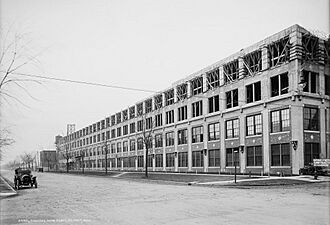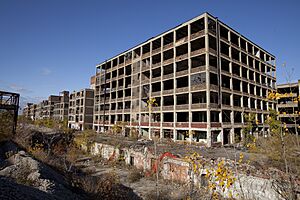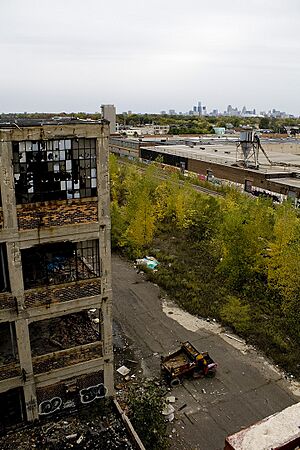Packard Automotive Plant facts for kids
Quick facts for kids Packard Automotive Plant |
|
|---|---|

The Packard Plant's administrative building during the addition of two floors circa 1911
|
|
| General information | |
| Status | Closed, Renovations Halted in October of 2020. Demolition began in October 2022, and second round began in January of 2023. Demolition halted in April 2023, no activity as of May 2023. |
| Type | Automobile factory |
| Location | Detroit, Michigan, U.S. |
| Coordinates | 42°22′46.62″N 83°1′44.14″W / 42.3796167°N 83.0289278°W |
| Construction started | 1903 |
| Completed | 1911 |
| Technical details | |
| Floor area | 3,500,000 sq ft (330,000 m2) |
| Design and construction | |
| Architect | Albert Kahn |
The Packard Automotive Plant was a huge factory in Detroit, Michigan, where fancy cars were made. The Packard Motor Car Company built luxury cars here. Later, the Studebaker-Packard Corporation also used the plant.
Demolition of parts of the plant started in October 2022. More demolition happened in January 2023. However, the demolition work stopped in April 2023. Today, the Packard Plant is mostly empty and partly torn down. Many parts of the old factory still stand.
Contents
Building the Plant: Design and Use
Packard's Era: Making Cars
The Packard plant was enormous, covering 3,500,000 square feet (about 325,000 square meters). It sat on 40 acres of land in Detroit. The famous architect Albert Kahn designed it. This factory was one of the first in the U.S. to use strong, reinforced concrete for industrial buildings.
The plant opened in 1903. It was considered the most modern car factory in the world at that time. It was huge and very efficient. By 1908, the factory was six times bigger than when it first opened. At its busiest, about 40,000 people worked there. These workers were skilled in over eighty different jobs.
The plant made Packard cars from 1903 until 1956. During World War II, the factory switched to making war supplies. They notably built the Packard V-1650 Merlin engine. This powerful engine was used in the North American P-51 Mustang fighter plane.
After Packard: New Uses
The factory complex officially closed in 1958. However, some other businesses used parts of the buildings for storage until the late 1990s.
In the 1990s, the empty buildings became famous for hosting "underground" music parties. These were called raves or techno parties. The city of Detroit took over most of the property in 1994. This happened because the previous owners had not paid their taxes.
Some outer buildings were still used by businesses into the early 2000s. The very last tenant, Chemical Processing, left the plant in 2010. They had been there for 52 years. After that, the site became a popular place for filming movies and TV shows.
The Plant Today: What It Looks Like
Since it was abandoned, the plant has attracted many people. It became a spot for graffiti artists to create art. People who enjoy exploring old buildings also visited. Sadly, vandals also came and removed wires and other building materials. In one strange event, vandals pushed a dump truck from the fourth floor!
Karen Nagher, who works to save old buildings, was upset. She said people came from "all over the world" to explore the plant. She worried that they were "disassembling those buildings, making it harder and harder to restore them."
Even after many years of neglect, the strong concrete structures are mostly still standing. Some parts of the upper floors have fallen or been partly torn down. This happened because of several failed attempts to demolish the plant over the years.
In February 2013, some people put up signs on a bridge at the plant. The signs spelled out a Nazi slogan. Community volunteers quickly removed these inappropriate letters.
The plant has also been a filming location. In April 2013, the TV show Low Winter Sun filmed there. In June 2018, Amazon's show The Grand Tour filmed an episode in Detroit. The Packard Plant was shown a lot in that episode.
On January 23, 2019, a bridge at the plant collapsed. Luckily, no one was hurt. In February 2019, a part of the plant owned by the city was torn down.
Selling the Plant: Who Bought It?
Because of unpaid taxes, the plant was put up for auction in September 2013. The starting price was $975,000, which was the amount of taxes owed. No one bought it at that price.
Another auction happened in October 2013. This time, the starting bid was only $21,000. A doctor from Texas, Dr. Jill Van Horn, made the highest bid of $6,038,000. She said she wanted to work with partners to turn the site into an "economic engine." She hoped to fix up the plant to build manufactured houses. However, she missed the payment deadline.
The county then talked to the second-highest bidder, Bill Hults. He was a developer from Chicago. He made some payments but also failed to pay the full amount.
Around the same time, a Spanish investor named Fernando Palazuelo became interested. He bought the plant for $405,000 on December 12, 2013. Palazuelo had experience fixing up old buildings in Spain and Peru. He planned to use the Packard Plant for many different things. These included homes, shops, offices, light industry, recreation, and art. He estimated the project would cost about $350 million over 10 to 15 years. He hoped to bring a car parts maker to the plant. He also wanted to create art studios for local artists and even a fancy go-kart track.
By August 2016, no major work had started on the plant. Many people were doubtful that such a huge and expensive project would ever begin.
Trying to Renovate
In May 2017, Palazuelo's company, Arte Express, held a special ceremony. This marked the start of the first part of the project. This phase would include the old administrative building, which was 121,000 square feet. On August 12, 2017, the public was able to take a tour of the property for the first time. They could even go to the second floor of the administration building.
Demolition Begins
The city tore down some structures at the Packard Plant that it owned in 2017. In October 2020, it was announced that the original plans for fixing up the plant were stopped. Palazuelo decided to sell the property. He thought it would be better to tear down most of it to make space for new industrial businesses.
On April 7, 2022, a judge ordered the demolition of the plant. The judge said it had become a public problem. The city started looking for companies to do the demolition. In July 2022, the Detroit City Council approved a contract for nearly $1.7 million to tear down a part of the plant.
Demolition began on October 27, 2022, on one building. Another part of the plant started to be torn down on January 24, 2023. By the end of March, this demolition was successful. However, in early April, all demolition work at the plant stopped. This happened because the owner paid their property taxes before the deadline. This allowed them to keep ownership of the privately owned parts of the plant. New "NO TRESPASSING/PRIVATELY OWNED" signs were put up.
The city of Detroit said they would save some buildings of the Packard Plant. This is to protect its history. But they also plan to continue tearing down other parts of the plant throughout 2023.
On March 4, 2024, demolition started again. The City of Detroit plans to clear the site by the end of 2024. They will use money from the American Rescue Plan. Two sections of the plant, facing each other across East Grand Boulevard, will be saved. These parts are important for their historical meaning.
See also




